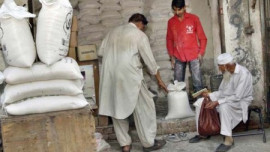
While the total number is the same, there is marked difference between the PSDP document that the government unveiled on Friday and the one approved by National Economic Council on last Monday. After the NEC meeting, the Ministry of Planning and Development had to make over Rs50 billion in adjustments to create the fiscal space for two state-owned Liquefied Natural Gas (LNG) fired power plants to be set up at an estimated cost of Rs163 billion.
The NEC has authorised the Planning Ministry to make adjustments in proposed allocations. Initially, the Planning Ministry had conditioned the inclusion of the LNG-fired power plants into the PSDP on the Finance Ministry’s willingness to increase the development budget’s size to Rs758 billion. The Finance Ministry, however, refused to budget and the Planning Ministry had to retreat and added both the projects into the PSDP, allocating Rs45 billion for fiscal 2016.
To make room, it slashed the allocations of China Pakistan Economic Corridor’s proposed budget by Rs20 billion and cut the proposed development allocations of other ministries and agencies, mainly the National Highway Authority.
Against the NEC-approved allocation of Rs171 billion, the final development budget document shows CPEC project allocations at Rs151 billion, the third downward revision in less than two weeks. The Planning Ministry had originally proposed Rs191 billion for CPEC projects.
For fiscal 2016, the government has proposed a Rs100 billion allocation out of the development budget for special development programmes for temporarily displaced persons and security enhancement. Another Rs20 billion has been allocated for the Prime Minister’s Youth Programme. For discretionary development projects identified by parliamentarians, another Rs20 billion has been allocated.
Compared with the NEC-approved document, the federal government reduced the allocations of federal ministries and divisions by Rs13 billion to Rs253.2 billion in the new budget.
The Water and Power Ministry’s water development projects have seen their allocations reduced from Rs46 billion to Rs31.2 billion. However, the power sector allocation to the Water and Power Development Authority (Wapda) has been increased to Rs112.2 billion in the new budget, including Rs45 billion for the LNG-fired power projects.
The development budget for the Pakistan Atomic Energy Commission (PAEC) budget has also been reduced from Rs59.3 billion to Rs30.4 billion for fiscal 2016.
The government also made a second downward adjustment in the development budget for the National Highway Authority for fiscal 2016. It had originally proposed a Rs200 billion allocation, which was first reduced to Rs184 billion and now the final allocation is Rs160 billion.
It also reduced the allocations for Special Development Programmes in the provinces from Rs30 billion to Rs28 billion.
Pakistan Railways will get a Rs41 billion bailout. The Higher Education Commission has been given Rs20.5 billion, Rs4.5 billion less than this year’s HEC development budget. Kashmir Affairs and Gilgit-Baltistan have been allocated Rs23.2 billion and Rs19.7 billion to the State and Frontier Region’s Division.
CPEC
The bulk of the development budget will be focused on completing CPEC to keep Islamabad’s commitment to Beijing to complete at least one route of the corridor by later next year.
Despite the focus on CPEC, however, the government’s planning for the corridor projects seems haphazard, as the allocations for CPEC were changed for the third time. China wants to build a trade link through Pakistan aimed at using Gwadar port for strategic and commercial purposes. After a year of controversy, most political parties have finally achieved a consensus on the alignment of the corridor route.
In the new budget, the Interior Ministry has been given Rs3.5 billion to raise 28 Civil Armed Forces Wings to ensure the security of the CPEC routes and Chinese citizens working in Pakistan.
Western Alignment
Against the NEC’s approved plan of allocating 12% or Rs20.8 billion of CPEC projects for western route project, which passes through the relatively lesser developed provinces of Balochistan and Khyber-Pakhtunkhwa, the government has slashed the final allocation by Rs500 million to Rs20.3 billion.
Out of five projects that have been designated as western route projects, four are already under construction, one dating back to 1999, the second commenced in 2007, another one was approved in 2010 and one was approved last month. For land acquisition and construction of CPEC projects, the government has allocated Rs10 billion.
Eastern Alignment
The eastern route of CPEC, which will utilise the relatively better developed transportation infrastructure of Punjab and Sindh, will get the lion’s share of this year’s CPEC project allocations at Rs80 billion, though that amount has been cut by Rs15 billion.
Against the NEC-approved Rs60.2 billion for the construction of the 387-kilometre Multan-Sukker highway, the final PSDP document shows a Rs50.2 billion allocation for this critical project. The total cost of this project is estimated at Rs259.3 billion.
For the 296-km Sukker-Hyderabad highway, the NEC had approved Rs10.5 billion for fiscal 2016 but the final document shows a Rs5.5 billion allocation. The total cost of this project is Rs148 billion. The NEC approved Rs20 billion allocation for 230 km long Lahore-Abdul Hakeem section, which has been maintained in the final document.
Northern Alignment
The northern alignment’s NEC approved allocation of Rs32 billion has also been slashed by Rs4 billion to Rs28 billion. For construction of 120-km Thakot-Havelian section, the NEC had approved Rs23.5 billion but the government finally gave Rs20.3 billion. The total cost of this project is Rs95.4 billion. For acquisition of land for this project, the NEC approved another Rs6 billion, which has now been lowered to Rs5 billion.
The NEC approved a Rs2.3 billion allocation for construction work on the Burhan-Havelian road section, which the government has retained in the final document. For construction of the Islamabad-Mianwali-Dera Ismail Khan road, which will link the eastern route with the central route, the government has allocated Rs10 billion in the new budget.
To complete work on Gwadar port, the government allocated Rs6.8 billion for the next year. The government has also given Rs4.7 billion for construction of Eastbay Express way that will link Gwadar with Coastal highway. The total cost of the project is Rs14.1 billion. The NEC approved to give Rs2 billion to Pakistan Railways for conducting various studies to link Kunjerab through rail link.























COMMENTS
Comments are moderated and generally will be posted if they are on-topic and not abusive.
For more information, please see our Comments FAQ